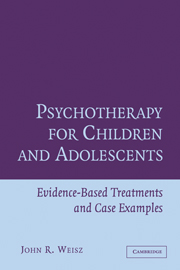Book contents
- Frontmatter
- Contents
- Preface
- SECTION A GENERAL INTRODUCTION
- SECTION B TREATMENTS FOR FEARS AND ANXIETY
- SECTION C TREATMENTS FOR DEPRESSION
- SECTION D TREATMENTS FOR ATTENTION DEFICIT/HYPERACTIVITY DISORDER
- SECTION E TREATMENTS FOR CONDUCT PROBLEMS AND CONDUCT DISORDER
- Introduction to Section E: The Case of Sal and Treatments for Conduct Problems and Conduct Disorder
- 8 Treating Conduct Problems by Teaching Anger Control
- 9 Behavioral Parent Training and Family Treatment for Conduct Problems
- 10 Parent-Child Interaction Treatments for Child Noncompliance
- 11 Parent Training through Video Modeling and Structured Group Discussion
- 12 Using Problem-Solving Skills Training and Parent Management Training for Children with Conduct Disorder
- 13 Multisystemic Therapy for Antisocial and Delinquent Youth
- SECTION F CONCLUSION
- References
- Author Index
- Subject Index
8 - Treating Conduct Problems by Teaching Anger Control
Published online by Cambridge University Press: 06 July 2010
- Frontmatter
- Contents
- Preface
- SECTION A GENERAL INTRODUCTION
- SECTION B TREATMENTS FOR FEARS AND ANXIETY
- SECTION C TREATMENTS FOR DEPRESSION
- SECTION D TREATMENTS FOR ATTENTION DEFICIT/HYPERACTIVITY DISORDER
- SECTION E TREATMENTS FOR CONDUCT PROBLEMS AND CONDUCT DISORDER
- Introduction to Section E: The Case of Sal and Treatments for Conduct Problems and Conduct Disorder
- 8 Treating Conduct Problems by Teaching Anger Control
- 9 Behavioral Parent Training and Family Treatment for Conduct Problems
- 10 Parent-Child Interaction Treatments for Child Noncompliance
- 11 Parent Training through Video Modeling and Structured Group Discussion
- 12 Using Problem-Solving Skills Training and Parent Management Training for Children with Conduct Disorder
- 13 Multisystemic Therapy for Antisocial and Delinquent Youth
- SECTION F CONCLUSION
- References
- Author Index
- Subject Index
Summary
Conduct problems have many causes, but it is often possible to spot flash points at which behavior gets out of control. One of the most common is the burst of anger, during which rational problem solving and self-control are abandoned, and aggressive behavior erupts. The case of Sal illustrates how this works. Quick to assume that others mean him harm, he explodes in a fury at the slightest evidence of disrespect, or at an ambiguous encounter with a peer. One way to treat conduct problems like Sal's is to defuse the explosives before they ignite.
A tendency to give in to angry impulses has been the target of considerable clinical research on aggressive behavior. Rule and Nesdale (1976) reported that anger arousal operated as a mediator of aggressive behavior, and Bandura (1973) and Camp (1977) offered evidence that poor verbal skills for coping with stress, and insufficient cognitive processing of stressful events, may lead to anger and aggression. Building on such notions, investigators have developed two partially overlapping treatment programs intended to reduce aggression by helping young people overcome their tendency toward angry outbursts. Here we describe the two programs and the evidence on their effects.
Anger Control Training with Stress Inoculation: Conceptual Basis and Procedural Overview
The first of the two programs, Anger Control Training with Stress Inoculation (Feindler et al., 1984; Schlichter & Horan, 1981), appears to be built on an important two-part assumption – the idea that an explosive style can arise in part because of deficits in youngsters’ understanding of the factors that spark their angry arousal, and in part because of a failure to learn coping skills – or at least a failure to establish the skills firmly enough to withstand the force of real-life challenges.
- Type
- Chapter
- Information
- Psychotherapy for Children and AdolescentsEvidence-Based Treatments and Case Examples, pp. 255 - 282Publisher: Cambridge University PressPrint publication year: 2004

